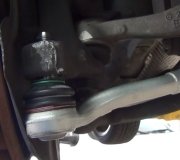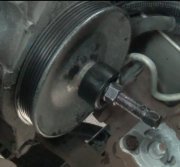Altered suspension ride height is very bad news. When I was the suspension and alignment specialist at a very nice family-owned new-car dealership, the owners allowed me to refuse to work any lowered car or raised truck because we knew we could become party to any future lawsuit, even when it didn't involve anything I worked on.
The first thing you have to look at is the lower control arm. It is supposed to be perfectly parallel to the ground. When it is, you will find the upper control arm is angled down toward the ball joint quite a bit. The difference in those two angles causes the wheel to tip in and out on top as the suspension goes up and down over bumps in the road. That action greatly reduces tire wear from the scrubbing as it slides left and right across the road surface. When the truck is raised with taller coil springs or turning up torsion bars, all that geometry is changed. The wheels do not go through the proper dynamic motions, even if they are adjusted to specs on the alignment rack. You will have reduced handling, braking ability, steering response, and tire wear. Lawyers and insurance investigators know all about this and will use it to shift part of the blame for a crash from their client onto you. That is why mechanics do not want to get involved.
You will notice the steering linkage at each wheel is almost parallel to the lower control arm, but not exactly. Also, the pivot point of the inner tie rod end's ball and socket is almost inline with the lower control arm's pivot bushings, but not quite. Those slight differences keep the two front wheels parallel to each other when cornering and one corner drops down from weight transfer. With the front end sitting too high, steering changes caused by height changes in the control arm are not matched with steering changes in the steering linkage. When one tire hits a bump in the road, that wheel will change direction but it is not offset by an equal and opposite change in the other wheel. That is the cause of your steering wander. GM's steering systems have very little trouble with steering wander, as long as no parts are worn.
A truck can also be lifted with "drop spindles". Those keep the suspension ride height stock, but lower the wheels on the spindles, thereby lifting the truck higher, similar to parking on 2x6 pieces of lumber. You have to step higher to get in, but the suspension geometry has not been altered. What is different is "scrub radius". If you draw an imaginary line between the two steering pivot points, in this case, the upper and lower ball joints, that line will intersect the tire tread at the road surface at a very carefully-designed-in point near the middle of the tread. The half of the tread to the left of that point makes the tire want to pull to the left, and the tread to the right of that point makes it want to pull right. Those two forces offset each other. When one tire hits a bump, each force still counteracts the other one and that tire does not react to the bump by causing a momentary pull. A wider wheel, one with a deeper offset, a different tire diameter, or raising the ball joints changes scrub radius. Now a larger percentage of tread is on one side of that point and less is on the other. When that tire hits a bump, it is going to respond to the larger part and momentarily tug that way. When not hitting a bump, most of the vehicle's weight is on the right tires since roads lean to the right. The vehicle will tend to follow what the right tire wants to do most of the time, except when bumps are involved.
It also bares mentioning that very few people consider the control arm bushings when altering ride height, (and when replacing those control arms). The arms are replaced while the vehicle is on a hoist or jacked up. That leaves the arms hanging down. If the pivot bolts are tightened that way, when the vehicle is set down on the tires, the arms level out, then the bushings are clamped in a permanent twist. Normal driving that runs the suspension up and down will twist the bushings beyond their limit to flex, and can tear them loose or greatly reduce their life. A lot of inexperienced mechanics are guilty of this too.
SPONSORED LINKS
Tuesday, January 2nd, 2018 AT 6:06 PM




